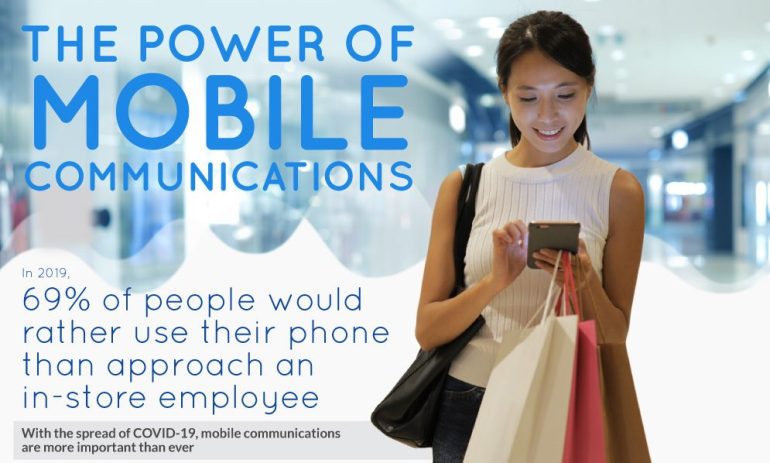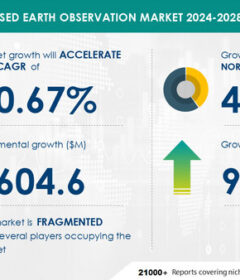As technology changes so does the way we interact with each other. Before smartphones and ordering online, popping into a shop to search for a particular item or calling around to find it before heading out were both common things to do. The internet and later smartphones changed all that. Now we have access to whatever information we need right at our fingertips at all times. If we are searching for something hard to find we can simply order it online. If we are planning to go purchase something in person or we want more information about an item before we buy it, we often consult our smartphones for further information rather than asking a store employee for help. In fact, even before the COVID-19 pandemic, 69% of people would rather search for information on their phones instead of asking for help from a store employee, and the pandemic has just made this practice all the more practical.
All the information and technology we carry around in our pockets has changed the way we interact with the world. We send text messages and emails more frequently than calling now and if we don’t know something it’s just a matter of knowing how to find it. With the spread of the pandemic accessing information has become even more crucial. We can look up mask policies and procedures before we go to a business, find out if a business has special hours for those with disabilities and the elderly, and look up every-changing hours and services.
Consumers And Mobile Communication
Before the pandemic, 81% of consumers used mobile to manage finances, while 79% used mobile to make online purchases. Any why wouldn’t they? The days of getting up and going to the computer every time you wanted to look something up, pay a bill online, or buy something are long over.
Increasingly, stores are giving information to consumers that they have never given out before. One of the things customers can look for online with many businesses is not only where an item is located in a store, but also how many of that item are in stock at any given time. Customers want accurate information and they want it now, as their time is becoming more valuable than ever. What’s more, knowing you will find what you are looking for before you leave the house is actually pretty critical during the age of social distancing.
Mobile Communication In Retail
Communicating with customers is changing thanks to the mobile revolution. Answering phone calls from customers is no longer the main interaction with them. In fact, 85% of those who own smartphones prefer text messages to calls or even emails, which means that businesses that aren’t responsive to this type of communication are likely missing out on customers.
55% of people ignore marketing emails because they get too many emails, and 29% never listen to voicemail. On the other hand, 90% of people open a text message within minutes. In fact, there is a:
- 98% open rate for text messages versus 20% for email
- 45% response rate with text messages versus 6% for email
- 90 second response time for text messages versus 90 minutes for email
Before the COVID-19 pandemic 68% of businesses were already using some form of messaging to connect with their customers. This placed them in a considerably better position when the pandemic hit because they already had the infrastructure in place to meet the changing needs of customers in response to social distancing.
Now customers need information before they show up to a business, and mobile messaging is the way they often prefer to receive it. Curbside pickup has doubled since last year and 59% of customers plan to continue using it after the pandemic passes, and this service is made possible through the use of mobile messaging.
Mobile Communication In Foodservice
Mobile ordering and messaging has also been a boon to restaurants since the start of the pandemic. In many places restaurants have only been open for takeout orders, so having apps and messaging abilities for taking orders and telling customers when their orders are ready has helped them to run on a skeleton crew while making the changes necessary to function as a takeout only business.
In March of this year pizza deliveries went up 44% in a single week, and many companies used online ordering and mobile communication to ensure contactless deliveries.
As restaurants begin to reopen with new social distancing guidelines in place, mobile messaging helps to keep communication going for reservations, when tables are ready, and more.
Mobile Communication In Medicine
Accessing medical services has been challenging because of the pandemic, and early on laws were relaxed to allow people to access telehealth services. In order to make the transition easier for medical providers and patients alike, all messaging and video call services were allowed so that doctors could get care to those who needed it via whatever means they were able to use. Teladoc saw a 50% increase in use in the first week alone.
Mobile messaging can be used for appointment reminders, prescription refill verifications, and more, and 72% of organizations plan to implement more and better digital customer experiences throughout the rest of 2020.
Mobile Communication In Customer Service
When it comes to customer complaints, nothing makes customers angrier than sitting on hold for hours waiting for their call to be answered, which makes it not the best way to solve customer complaints to begin with.
Chats and mobile messaging give customers the ability to initiate contact and then do other things while they await a response. It’s a much less stressful way to deal with contacting customer service, and it’s a lot more effective than airing out grievances on social media, which can come back around with undesirable consequences later on.
But text messaging has to go both ways. It’s not enough to send marketing messages via SMS, businesses also need to be able to respond to messages they receive. One in three customers report sending a message to a company and never hearing back from them, and in many cases it is simply because the company has not enabled two way messaging.
65% of customers have positive feelings toward businesses that offer messaging as a means of communication, likely because it shows the company respects the customer’s communication style and choices.
Harnessing The Power Of Mobile Communications
Customers say that businesses that offer messaging respect their time, which makes them more likely to choose to do business with that company. It also means those happy customers are more likely to recommend that business to friends and family.
As technology changes, the ways that businesses interact with customers have to keep up with the times. The first rule of customer service is to meet customers where they are, and if that means hanging up the phone and sending out a text message that’s how it has to be.
Mobile communication is likely to hinge on SMS messages for some time to come, and businesses that aren’t already using this method are missing out on business. Is your business ready to harness the power of mobile communication?




